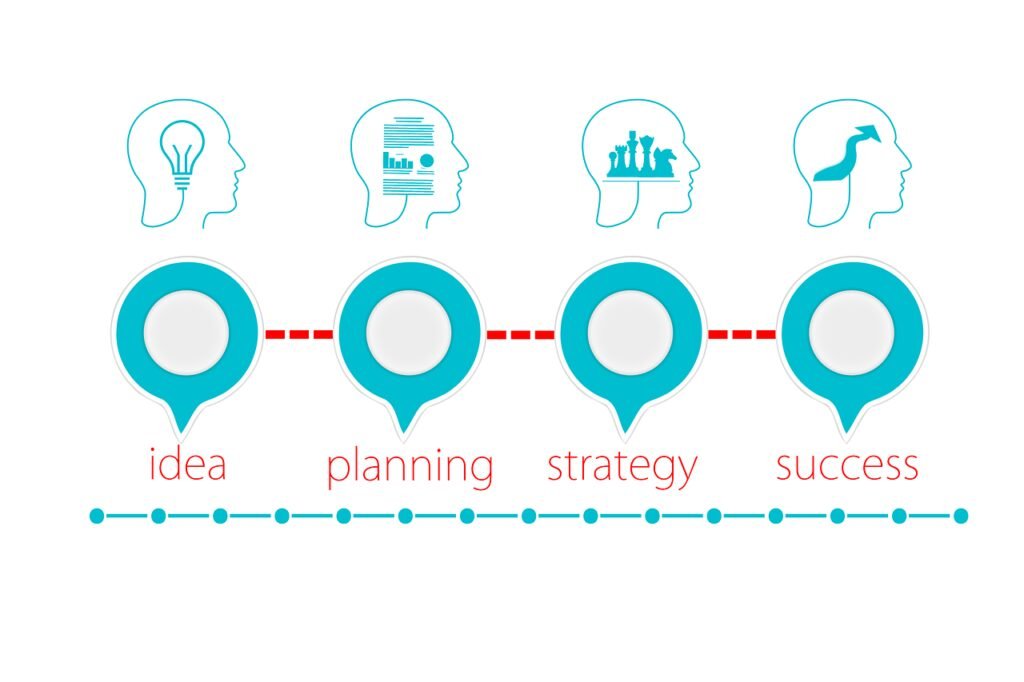Think of content as a magnet, when written well, it attracts users to itself and when it is poorly written, it repels your site visitors.
The goal of content is to attract. To attract, you need to craft content that brings value to the table of your users. It should also be interesting because that`s what keeps your prospects on till they find the value in your content.
Content is really what your customers engage with, not you, not your brand title, it is the content you offer that audience engages with. It is from content that they form an impression of what you represent and what your brand stands for.
From the above, you can tell that content is the backbone of marketing. Simply put, marketing does not work without content.
How are you going to woo customers into your sales funnel if you have nothing to show or say to them? In the world of marketing without content is being without a tongue, legs, or hands to make gestures.
So as with other forms of marketing, content marketing cannot work without content.
This article will walk you through everything you need to know about content marketing and to start, let’s answer the itching question on your mind
Table of Contents
ToggleWhat is Content Marketing?
“Content marketing as defined by the Content Marketing Institute is a strategic marketing approach focused on creating and distributing valuable, relevant, and consistent content to attract and retain a clearly-defined audience and, ultimately, to drive profitable customer action.”
If that definition has not settled your mind, then simply put, content marketing is any form of content from videos, photos, infographics, texts, and other forms that are created to inform and convert your target audience.
Types of Content Marketing
#1. A Blog
Blogging is a fantastic tool for building a content marketing strategy, this is because it is the part of your site that you will most frequently update with new posts and information to keep readers engaged.
It is often through blog content that you first entice people to your site and start to build your brand’s audience.
With a functional blog that regularly churns out quality, relevant and interesting content, you establish your brand as an authority in your niche.
For businesses, blogging is one of the most popular lead-generating tools you can use to earn more customers for your business.
Establishing a blog will help enhance your SEO marketing strategy and improve your search results on SERPs.
When people find the content in your blog helpful, they will also create links to individual pages which can build your organic backlink profile. These benefits will help boost your ranking, and therefore your visibility.

#2. Videos
It’s no surprise that Hollywood filmmakers and TV executives continue adapting popular books and retelling the stories using sound and visuals.
Movies and shows communicate information more efficiently via easy-to-process demonstrations or visual aids.
Try reading about the Jewish chicken soup with horseradish dill matzo balls recipe, it’s complicated compared to just live-streaming a chef who teaches you how to do it.
Video has dethroned every other form of content to take the place of an unthreatened king of contents.
#3. Infographics
Infographics help you to convey information more effectively and creatively by pairing powerful storytelling and strong data presentation.
This form of content combines the written word with visual elements to pack big ideas into small spaces. Presenting information in such a compelling fashion encourages visitors to spend time on your site, consuming and sharing more of your content.
With the right use of color, proportion, and negative space, information can be transformed into memorable, attention-grabbing, and even persuasive graphics making it very easy for users to digest.
The reason most marketers tend to prefer this type of content marketing over others is that it combines the best of both worlds.
#4. Podcasts
Not only does podcast advertising generate far better brand recall than other widely-used forms of digital advertising, but Nielsen studies revealed that 61% of consumers exposed to podcast ads for well-known major national brands become more likely to purchase advertised products.
These high stats may not be unrelated to the fact that Podcasts offer a unique marketing opportunity that has helped many companies explode. 67% of podcast listeners enjoy ads. Podcasts overall have 62 million listeners each week. Podcast advertising yields leads with a conversion rate seven times higher than leads from regular website traffic.
Yes! You read that right.
The strength of this content form lies in scale, trust, and recall.

#5. Webinars
A high 66% of B2B customers prefer to watch a webinar before they buy a product, according to Demand Gen Report’s survey.
A webinar is a powerful form of content marketing that let you get right in front of your target audience and have real-time interactions with them.
For businesses looking to improve the effectiveness of their content marketing, hosting a webinar can be a valuable tool.
Webinars became more popular and relevant during and after the pandemic the world has been facing.
Webinars are a great idea for businesses to raise awareness around a particular problem they’re solving.
They are useful for companies because they showcase their products to audiences that are willing to use them.

The 5 Components of a Content Marketing Strategy
#1. Brand`s focus
Before your content marketing campaign engages the gear, there is first the need to Know your company`s ‘why’ to focus on ‘where’ and ‘how’ with your marketing.
Every business has a corporate identity, which includes mission, culture, relationships, and core values and promises.
So before you think of marketing, think first about your company`s core values, mission, and promises.
Doing this is putting the cart before the horse and this often results in broken links in the middle of content marketing. So there is every need to think about your brand`s focus before crafting content for your marketing.
Your brand represents you and your promise to your customer. Your brand helps you create clarity and stay focused. Your brand helps you connect with your customers emotionally.
Now when you don’t think first about what you represent in the minds of your audience, you might end up with content that does represent you and does not resonate with your audience.

#2. Customer Experience
Understanding customer needs, desires, or pain points is a great way to craft content that is received with satisfaction by your target audience.
After all, what is the use of content if it doesn’t resonate with your target audience?
Today, customers have power over the market, not the sellers anymore, so it should be about them. Businesses live and die based on customer buy-in.
Figure out what their needs are. What are your customers’ search intents? Do they look for information related to your brand? Can you provide quality information to them related to their search?
Digging for customer experience allows marketers to get to the heart of what people want and also get into the heart of those people when they offer them exactly what they are looking
Here are the stages in which you can define your customer experience:
#1.Develop customer journeys with your brand
#2. Analyze your customer data
#3. Create customer personas

#3. Content
While conducting audience analysis, you must have gotten an idea about the sort of content your audience will resonate with, and what content will address their pain points.
As we have mentioned above, content is the backbone of marketing, it has to be crafted solidly
At this stage, you need to stop and ask these questions and give sincere answers to each
#1. Whom are we trying to reach?
#2. What do you want to accomplish with this marketing outing?
#3. What are our competitors doing?
#4. Do I have the budget I need to pull this off?
Once you are sure of your content goals, follow these steps:
#1. Define your messaging and brand story
#2. Analyze the existing content
#3. Make a content plan — visualize your content design and set deadlines
#4. Define a mix of content you want to create videos, audio files, websites, and so on
#5. Identify the team who is going to work on the content
#6. Define the roles and responsibilities of each member of your team
#4. Channel Promotion
Now you are done creating content, your next worry should shift to one of the most important elements of this marketing mix, channel promotion.
It is the path that content takes from the point of production to the end-user.
After all, what is the use of great content if it does not reach those it was crafted for. Any business should consider maximizing its channel of promotion to ensure that customers receive their products.
These are the primary links between a brand and its target so the decisions around this must be well thought out to successfully reach your target.
There are different types of channels promotion available for you to utilize. You can determine which one to use based on the size of your company and the goal of your ad.
#6. Action Plan
Action Plans are useful because they give you a framework for thinking about how you’ll complete a project efficiently. They help you finish activities in a sensible order, and they help you ensure that you don’t miss any key steps.
It assures that you will act with purpose and a clear goal, rather than trying to “figure it out” as you go along. This is particularly effective if there is more than one person involved in the project.
You know where to begin and where to end.
That said, some more dynamic folks do better with the “figuring out along the way process” perhaps because they have their own, more emotional approach.
There is no need to judge yourself or others if one is more comfortable with their approach.
A good plan in advance though is likely to make things go smoother and potentially less frustrating.
Simply put action plan is the Blueprint for success. Without an action plan, no one will start his or her project. It is everything. It provides guidance, a schedule, and a clear direction to proceed.

Why Is Content Marketing Important?
Content marketing can be worth it, but perhaps it’s not meant to drive the hard ROI everyone expects. That’s because what we like to refer to as lead generation, one of the often mentioned goals of content marketing, is a little broken here.
“Leads” are misleading, mostly because a content download itself is not a lead. Just because someone fills out a form and grabs your report doesn’t mean they’re going to buy your product now or ever.
It doesn’t have to be overly complicated, either, but the rhetoric surrounding content marketing ROI has just gotten too unrealistic.
According to Content Marketing Institute’s 2016 Benchmarks report, 55 percent of marketers are unsure what content marketing success even looks like.
That’s a staggering figure considering that billions of dollars in marketing budgets are at stake. Many marketers struggle to set up the right goals and processes before they start publishing.
Then, when there aren’t enough sales opportunities to satisfy the execs, there’s a mad scramble to figure out what went wrong. At that point, it’s already too late; your content was destined to fail.
This isn’t to say that leads, downloads, and dollars are unimportant, but they’re factors that we should be looking at down the line. It takes months, if not years, for companies to translate content into sales opportunities.
No matter how you measure its impact, quality content still matters. In a survey, respondents indicated that brands that don’t produce good content are out of touch.
If you create helpful content, however, people will think you’re knowledgeable. If you create content that is informative and helpful, they’ll value you as a resource and respect your brand.
If they repeatedly come to you as a resource and require your product, then they’ll think of you before your competitors.
In other words, content marketing is worth it, as long as you know what to expect.
Conclusion
What did we miss? I am not sure we did touch on everything important in content marketing; we said content marketing is important because it helps to build relationships with your customers.
We also said by creating content that is valuable and interesting, you can create a following that will support your business and help you to sell more products and services.
Additionally, we said good content can help to improve the visibility of your website and make it easier for people to find what they’re looking for.
We took you through this worthwhile journey telling you about the goodness of content marketing and the key components to consider when planning content. Now you are ready to plan an effective content marketing that will shake hands with success.








